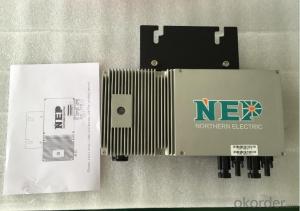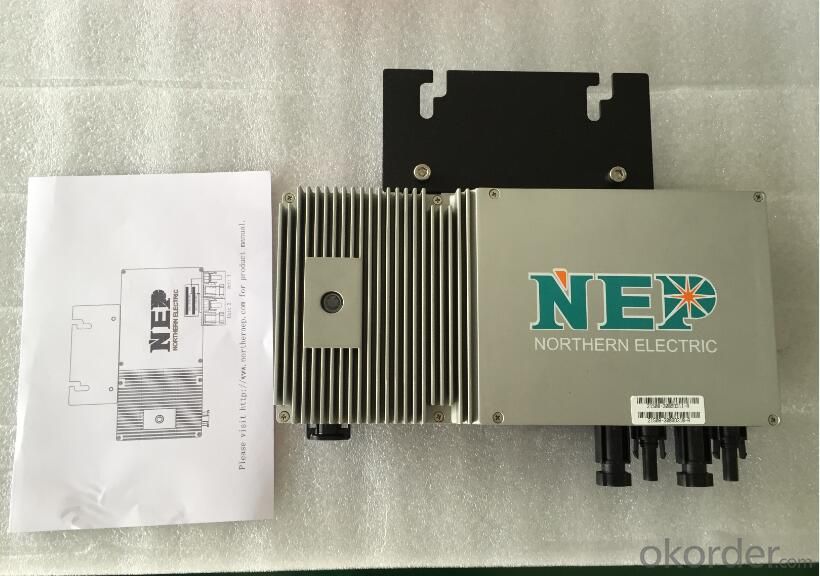High efficiency ON grid tie Micro-Inverter BDM-300*2
- Loading Port:
- Qingdao
- Payment Terms:
- TT OR LC
- Min Order Qty:
- 100 unit
- Supply Capability:
- 10000 unit/month
OKorder Service Pledge
OKorder Financial Service
You Might Also Like
Item specifice
To ensure the BDM-300X2 is not disconnected from the PV modules under load, adhere to the following disconnection steps in the order shown:
1. Disconnect the AC by opening the branch circuit breaker.
2. Disconnect the first AC connector in the branch circuit.
3. Cover the module with an opaque cover.
4. Using a DC current probe, verify there is no current flowing in the DC wires between the PV module and the BDM-300X2.
5. Care should be taken when measuring DC currents, most clamp-on meters must be zeroed first and tend to drift with time.
6. Disconnect the PV module DC wire connectors from the BDM-300X2.
7. Remove the BDM-300X2 from the PV array racking.
Installing a replacement BDM-300X2
1. Attach the replacement BDM-300X2 to the PV module racking using hardware recommended by your module racking vendor
2. Connect the AC cable of the replacement BDM-300X2 and the neighboring BDM-300X2 to complete the branch circuit connections.
3. Complete the connection map and connect the PV Modules.
1) Complete the connection map
2) Each BDM-300X2 has a removable serial number located on the mounting plate. Enter this serial number into a BDG-256, and correspond it to a number in the connection map.
3) Connect the PV Modules
4) Completely install all BDM-300X2 and all system inter-wiring connections prior to installing the PV modules.
a) Mount the PV modules above their corresponding BDM-300X2. Each BDM-300X2 comes with two oppositely sexed DC connectors.
b) First connect the positive DC wire from the PV module to the negatively marked DC connector (male pin) of the BDM-300X2. Then connect the negative DC wire from the PV module to the positively marked DC connector (female socket) of the BDM-300X2. Repeat for all remaining PV modules using one BDM-300X2 for each module.
| |
- Q:How do you calculate the total power capacity for a solar inverter?
- To calculate the total power capacity for a solar inverter, you need to consider the maximum power output of the solar panels connected to it. The total power capacity of the inverter should be equal to or greater than the total maximum power output of all the solar panels combined. This ensures that the inverter can handle the maximum power generated by the solar panels and efficiently convert it into usable electricity.
- Q:Can a solar inverter be connected to a computer or smartphone?
- Yes, a solar inverter can be connected to a computer or smartphone. Many modern solar inverters come with built-in Wi-Fi or Bluetooth connectivity, allowing users to monitor and control their solar energy system through dedicated apps or web portals on their computers or smartphones. This enables real-time monitoring of energy production, system performance, and even allows for remote troubleshooting and adjustments.
- Q:How does a solar inverter handle voltage stability in the grid?
- A solar inverter manages voltage stability in the grid by regulating the voltage levels of the electricity generated from the solar panels. It ensures that the voltage produced by the solar panels matches the voltage required by the grid, thus maintaining a stable and consistent voltage throughout the system. Additionally, solar inverters may also have features like reactive power control and voltage regulation capabilities, which further contribute to maintaining voltage stability in the grid.
- Q:Can a solar inverter be used with different communication protocols?
- Yes, a solar inverter can be used with different communication protocols. Many modern solar inverters are designed to be compatible with various communication protocols such as RS485, Modbus, Ethernet, or Wi-Fi. This allows for flexibility in integrating the inverter with different monitoring systems or smart home automation platforms.
- Q:What is the role of a solar inverter in grid management and stability?
- The role of a solar inverter in grid management and stability is to convert the direct current (DC) electricity generated by solar panels into alternating current (AC) electricity that can be fed into the grid. It ensures that the electricity generated by the solar panels is synchronized with the grid's frequency and voltage, thereby maintaining grid stability. Additionally, solar inverters can also provide grid management functionalities like reactive power control and voltage regulation, helping to balance and stabilize the overall grid system.
- Q:What is the role of a transformer in a solar inverter?
- The role of a transformer in a solar inverter is to convert the direct current (DC) power generated by the solar panels into alternating current (AC) power that can be used by household appliances and fed back into the electrical grid. The transformer helps to step up or step down the voltage as necessary and provides isolation between the solar panels and the grid, ensuring safe and efficient power transmission.
- Q:How does the weight of a solar inverter affect its installation process?
- The weight of a solar inverter can affect its installation process in a few ways. Firstly, a heavier inverter may require additional structural support or mounting equipment to ensure it is securely installed. This could involve reinforcing the mounting surface or using specialized brackets or racks. Secondly, the weight of the inverter may impact the ease of handling and maneuvering during installation, especially if it needs to be installed in elevated or hard-to-reach areas. Lastly, the weight can also impact the overall logistics of the installation, including transportation, lifting, and positioning of the inverter.
- Q:How does a solar inverter handle islanding detection and prevention?
- A solar inverter handles islanding detection and prevention by constantly monitoring the grid and its own power output. If it detects a loss of grid connectivity, it initiates a process called anti-islanding, where it stops supplying power to the grid to prevent the formation of an island. The inverter accomplishes this by monitoring the frequency and voltage levels of the grid, and if it detects a deviation beyond a certain threshold, it disconnects from the grid within a specific timeframe. This ensures that the inverter does not continue to supply power to an isolated grid, which could pose safety risks to utility workers and damage electrical equipment.
- Q:How does a solar inverter handle electromagnetic interference (EMI)?
- A solar inverter handles electromagnetic interference (EMI) by incorporating various filtering techniques and shielding mechanisms. These include the use of EMI filters, capacitors, and transformers to minimize the impact of EMI on the inverter's performance. Additionally, proper grounding and shielding of sensitive components help to reduce the risk of EMI interference. Overall, the design and implementation of these protective measures ensure that a solar inverter can effectively handle and mitigate electromagnetic interference.
- Q:Can a solar inverter be used with different types of backup power configurations?
- Yes, a solar inverter can be used with different types of backup power configurations. Solar inverters are designed to convert the DC power generated by solar panels into AC power that can be used in homes or businesses. They can be used with backup power systems such as battery banks, diesel generators, or grid-tied systems with net metering. The inverter's ability to synchronize with different backup power sources allows for efficient and reliable energy supply in various configurations.
1. Manufacturer Overview |
|
|---|---|
| Location | |
| Year Established | |
| Annual Output Value | |
| Main Markets | |
| Company Certifications | |
2. Manufacturer Certificates |
|
|---|---|
| a) Certification Name | |
| Range | |
| Reference | |
| Validity Period | |
3. Manufacturer Capability |
|
|---|---|
| a)Trade Capacity | |
| Nearest Port | |
| Export Percentage | |
| No.of Employees in Trade Department | |
| Language Spoken: | |
| b)Factory Information | |
| Factory Size: | |
| No. of Production Lines | |
| Contract Manufacturing | |
| Product Price Range | |
Send your message to us
High efficiency ON grid tie Micro-Inverter BDM-300*2
- Loading Port:
- Qingdao
- Payment Terms:
- TT OR LC
- Min Order Qty:
- 100 unit
- Supply Capability:
- 10000 unit/month
OKorder Service Pledge
OKorder Financial Service
Similar products
New products
Hot products
Hot Searches
Related keywords


































